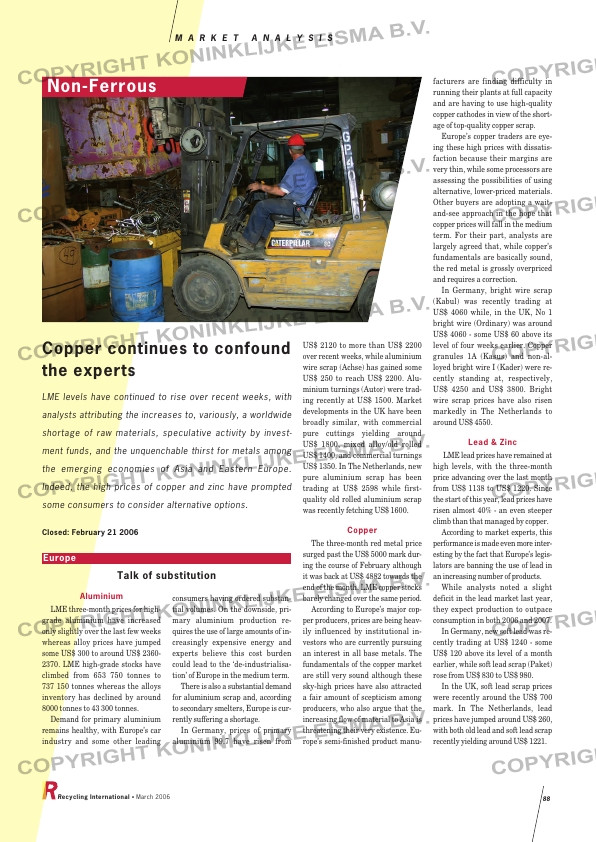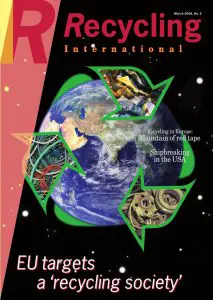Page 88 from: March 2006

M A R K E T A N A L Y S I S
Non-Ferrous
LME levels have continued to rise over recent weeks, with
analysts attributing the increases to, variously, a worldwide
shortage of raw materials, speculative activity by invest-
ment funds, and the unquenchable thirst for metals among
the emerging economies of Asia and Eastern Europe.
Indeed, the high prices of copper and zinc have prompted
some consumers to consider alternative options.
Copper continues to confound
the experts
Europe
Aluminium
LME three-month prices for high-
grade aluminium have increased
only slightly over the last few weeks
whereas alloy prices have jumped
some US$ 300 to around US$ 2360-
2370. LME high-grade stocks have
climbed from 653 750 tonnes to
737 150 tonnes whereas the alloys
inventory has declined by around
8000 tonnes to 43 300 tonnes.
Demand for primary aluminium
remains healthy, with Europe’s car
industry and some other leading
consumers having ordered substan-
tial volumes. On the downside, pri-
mary aluminium production re-
quires the use of large amounts of in-
creasingly expensive energy and
experts believe this cost burden
could lead to the ‘de-industrialisa-
tion’ of Europe in the medium term.
There is also a substantial demand
for aluminium scrap and, according
to secondary smelters, Europe is cur-
rently suffering a shortage.
In Germany, prices of primary
aluminium 99.7 have risen from
US$ 2120 to more than US$ 2200
over recent weeks, while aluminium
wire scrap (Achse) has gained some
US$ 250 to reach US$ 2200. Alu-
minium turnings (Autor) were trad-
ing recently at US$ 1500. Market
developments in the UK have been
broadly similar, with commercial
pure cuttings yielding around
US$ 1800, mixed alloy/old rolled
US$ 1400, and commercial turnings
US$ 1350. In The Netherlands, new
pure aluminium scrap has been
trading at US$ 2598 while first-
quality old rolled aluminium scrap
was recently fetching US$ 1600.
Copper
The three-month red metal price
surged past the US$ 5000 mark dur-
ing the course of February although
it was back at US$ 4882 towards the
end of the month. LME copper stocks
barely changed over the same period.
According to Europe’s major cop-
per producers, prices are being heav-
ily influenced by institutional in-
vestors who are currently pursuing
an interest in all base metals. The
fundamentals of the copper market
are still very sound although these
sky-high prices have also attracted
a fair amount of scepticism among
producers, who also argue that the
increasing flow of material to Asia is
threatening their very existence. Eu-
rope’s semi-finished product manu-
facturers are finding difficulty in
running their plants at full capacity
and are having to use high-quality
copper cathodes in view of the short-
age of top-quality copper scrap.
Europe’s copper traders are eye-
ing these high prices with dissatis-
faction because their margins are
very thin, while some processors are
assessing the possibilities of using
alternative, lower-priced materials.
Other buyers are adopting a wait-
and-see approach in the hope that
copper prices will fall in the medium
term. For their part, analysts are
largely agreed that, while copper’s
fundamentals are basically sound,
the red metal is grossly overpriced
and requires a correction.
In Germany, bright wire scrap
(Kabul) was recently trading at
US$ 4060 while, in the UK, No 1
bright wire (Ordinary) was around
US$ 4060 – some US$ 60 above its
level of four weeks earlier. Copper
granules 1A (Kasus) and non-al-
loyed bright wire I (Kader) were re-
cently standing at, respectively,
US$ 4250 and US$ 3800. Bright
wire scrap prices have also risen
markedly in The Netherlands to
around US$ 4550.
Lead & Zinc
LME lead prices have remained at
high levels, with the three-month
price advancing over the last month
from US$ 1138 to US$ 1220. Since
the start of this year, lead prices have
risen almost 40% – an even steeper
climb than that managed by copper.
According to market experts, this
performance is made even more inter-
esting by the fact that Europe’s legis-
lators are banning the use of lead in
an increasing number of products.
While analysts noted a slight
deficit in the lead market last year,
they expect production to outpace
consumption in both 2006 and 2007.
In Germany, new soft lead was re-
cently trading at US$ 1240 – some
US$ 120 above its level of a month
earlier, while soft lead scrap (Paket)
rose from US$ 830 to US$ 980.
In the UK, soft lead scrap prices
were recently around the US$ 700
mark. In The Netherlands, lead
prices have jumped around US$ 260,
with both old lead and soft lead scrap
recently yielding around US$ 1221.
Recycling International • March 2006 88
Closed: February 21 2006
Talk of substitution
RI_040 MA Non-Ferrous 23-02-2006 20:30 Pagina 88



